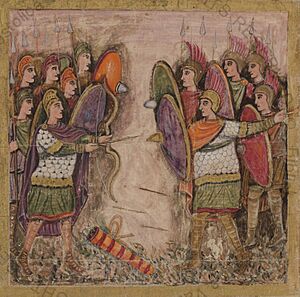Trojan Battle Order facts for kids
The Trojan Battle Order is a special list found in the second book of an ancient Greek poem called the Iliad. This list names all the different groups and their leaders who fought alongside the city of Troy during the famous Trojan War. It's like a roster of all the allies who came to help Troy.
Contents
Why is this list special?
This list, sometimes called the Trojan Catalogue, is much shorter than the list of Greek ships and soldiers that appears just before it in the Iliad. Experts have wondered why there's less detail about the Trojan side. Also, many important Trojan leaders mentioned elsewhere in the Iliad, like Priam or Paris, aren't even on this list!
Is the list historically accurate?
Many scholars believe that the Trojan Battle Order, and the Greek list too, might be very, very old. They think these lists could have come from the Mycenaean period, which was long before the Iliad was written down. This would explain why the authors of the Iliad might not have known as much about the places listed on the Trojan side, even if those places were in their own region.
For example, the list mentions a place called Alybe as the birthplace of silver. But a later Greek geographer named Hecataeus, who lived in the same area, didn't know where Alybe was. This suggests the information in the list was from a much older time.
Clues the list is ancient
There are other hints that the Trojan Battle Order might be a very old piece of writing that was added into the Iliad later.
- Out of 26 Trojans named in this list, only 5 are mentioned anywhere else in the entire Iliad.
- Major Trojan heroes like Priam, Paris, and Helenus are not on the list at all.
- Sometimes, the list gives different details about the same group of people compared to other parts of the Iliad. For example, the Mysians are led by different people and live in different places depending on which part of the poem you read.
These differences make experts think that the Trojan Battle Order was a separate poem or record that existed before the Iliad was fully put together.
Who fought for Troy?
The Trojan Battle Order names 16 different groups of fighters from 12 different peoples. These groups were led by 26 different commanders. They came from 33 different places.
| Line | Group Name | Leaders | Where They Were From |
|---|---|---|---|
| II.815 | Trojans | Hector | None stated (Troy) |
| II.819 | Dardanians | Aeneas, Archelochus, Acamas | None stated. |
| II.824 | Trojans from Mt. Ida | Pandarus | Zeleia |
| II.828 | No name given | Adrestus, Amphius | Adresteia, Apaesus, Pityeia, Mount Tereia |
| II.835 | No name given | Asius | Percote, Practius, Sestus, Abydus, Arisbe |
| II.840 | Pelasgians (spearmen) | Hippothous, Pylaeus | Larissa |
| II.844 | Thracians near the Hellespont | Acamas, Peiroüs | None stated. |
| II.846 | Ciconians (spearmen) | Euphemus | None stated. |
| II.848 | Paeonians (archers, "from far away") | Pyraechmes (and Asteropaios) | Amydon, river Axius |
| II.851 | Paphlagonians | Pylaemenes of the Eneti | Cytorus, Sesamus, along the river Parthenius, Cromna, Aegialus, Erythini |
| II.856 | Halizones ("from far away") | Odius, Epistrophus | Alybe |
| II.858 | Mysians | Chromis, Ennomus | None stated. |
| II.862 | Phrygians | Phorcys, Ascanius | "Far-off" Ascania |
| II.864 | Maeonians | Mesthles, Antiphus | Under Mt. Tmolus |
| II.867 | Carians | Nastes, Amphimachus | Miletus, Mt. Phthires, streams of the Maeander, crest of Mycale |
| II.875 | Lycians ("from far away") | Sarpedon, Glaucus | River Xanthus |
How the list is organized
The list starts with the Trojans themselves, led by their great hero Hector. Then it moves outwards, describing allies from nearby areas, and then from places further away. The groups from the most distant places are often described as "from far away."
The poem mentions that these allied groups spoke many different languages. This meant their commanders had to translate orders so everyone could understand. It's interesting to note that the Carians are specifically said to speak a "barbarian" language. This probably means their language was very different from the common language spoken in that part of the world at the time.
A long time ago, a Greek historian named Demetrius of Scepsis, who lived near Troy, wrote a huge book about this very list! Sadly, his book is lost now, but other ancient writers quoted parts of it.
See also
- Trojan Leaders


